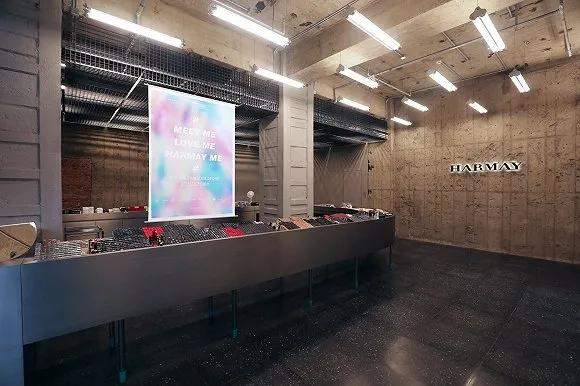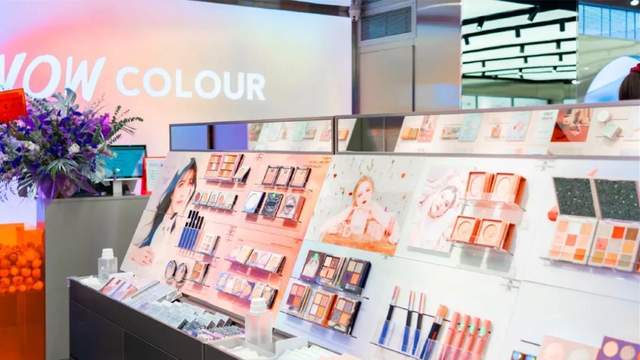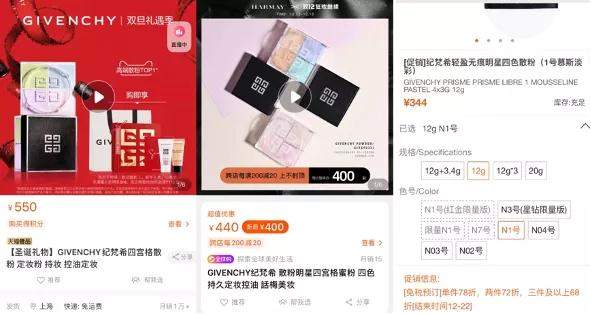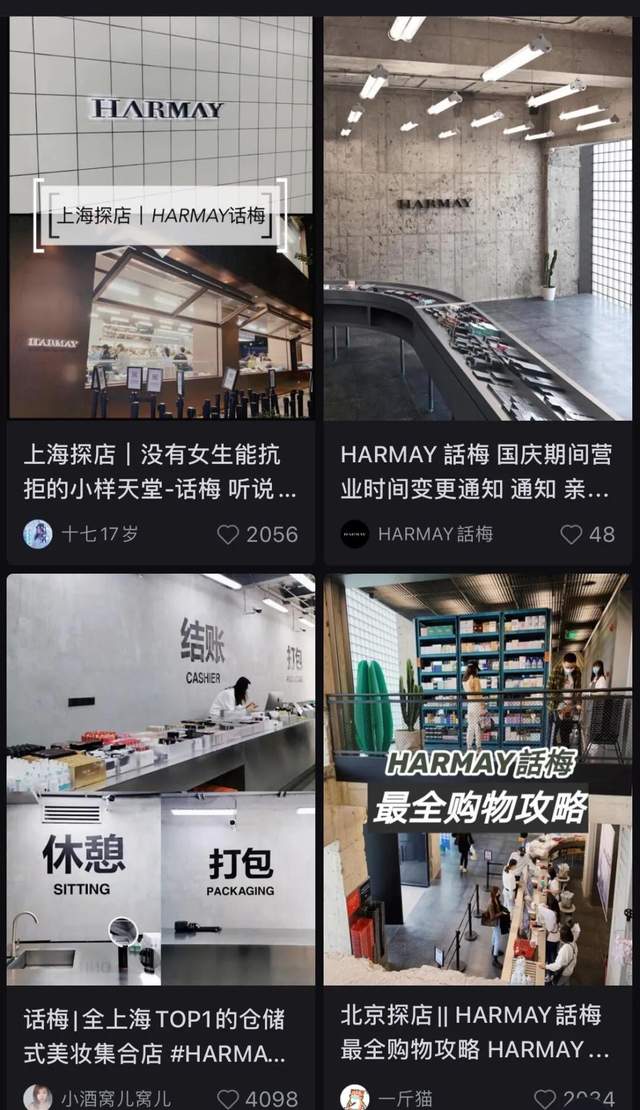
Wen’s Boiling Point, written by Huo Keni and edited by Yang Zhenxin.
A month ago, Yixian E-commerce, the parent company of Perfect Diary, a domestic beauty brand, successfully listed on the New York Stock Exchange, and its market value rose to nearly 7 billion US dollars, about 46 billion yuan, which reshaped people’s understanding of the beauty potential of Guochao. As the glory of domestic products in the beauty industry, Perfect Diary is a star company in Houlang who is very good at using the Internet for marketing. Led by it, new domestic products, including Huaxizi and Tangduo, keep heating up the online channels of beauty products and play the signboard of China cosmetics online.
At the same time, the hot atmosphere on the line also means that there are fewer retail opportunities under the beauty line.
Take the duty-free shop as an example. The continuous COVID-19 epidemic is bringing a series of side effects. The decrease in international navigation has led to a sharp drop in passenger flow at airport duty-free shops. In order to save themselves, duty-free shops have also begun to relax online purchase channels and discount conditions. Open the App of duty-free shop in Japan, and you can already see the discount prompt of 20% discount on the preferential list price.
Offline retail is cold, but fortunately, the cake in the beauty industry has not shrunk, and skin care and beauty is becoming an urgent need for all people regardless of age and gender. According to the report released by Zhiyan Consulting, the market size of China beauty industry will exceed 500 billion yuan in 2022, with a compound annual growth rate of about 6.77% from 2019 to 2023.
It’s just that the homogenization of online channels is getting more and more serious, and all brands want to fight their way out in Li Jiaqi’s "buy it, buy it".Therefore, how to seek differences and create characteristics in online and offline retail channels has become a problem that beauty brands consider in order to stand out.
The last earth-shaking beauty retail industry was the rise of online e-commerce companies such as Taobao and JD.COM, which attracted huge online traffic that offline stores could not imagine regardless of time and space and brand restrictions. By around 2015, the cost of online traffic acquisition has soared, and the incremental space has become smaller. The brand has begun to take offline again and think about how to make a fuss about offline channels.
Under this circumstance, the beauty entity economy that supplements consumers’ offline shopping experience has returned to the public’s field of vision. Instead of copying and pasting traditional stores, a number of local beauty collection stores with distinctive styles have emerged, which have impacted Sephora, an established world chain beauty experience platform, and Watsons, Asia’s largest cosmeceutical chain. Online and offline guide each other and rewrite the new retail pattern of beauty.
Among these representatives, Harmay Huamei, a high-end beauty collection shop featuring international first-line brands and overseas niche brands, The Colorist, the first global pure makeup collection shop to introduce cutting-edge concepts such as men’s makeup, gender-free makeup and skin care makeup in China, Wow Colour, a domestic beauty collection shop with an average price of no more than 100, and KKV, a cheap life house with multi-category container themes such as makeup, accessories, snacks and daily use.
Domestic beauty collection stores have sprung up, growing like mushrooms after rain, and occupying the market step by step.With more than ten years of online operation experience, Harmay Huamei started from Taobao in 2008, and sold over 100 million yuan in 2016. In 2017, it opened its first offline store in Shanghai. Two years later, it completed the A round of financing led by Gaochun Capital, with a valuation of nearly 500 million yuan. By October this year, Harmay Huamei had built five offline flagship stores.
Because it covers the first-line international brands such as Hailan Mystery, SK-II and Chanel, it also sells online celebrity niche products such as Suqqu, Le Labo and Ludan, which can only be purchased, and has many categories such as skin care, make-up, fragrance and lifestyle, and displays a large number of products in a centralized way in storage. Harmay is called "Costco" in the high-end beauty industry, allowing users to put all the favorite products of all brands in the beauty industry into one shopping basket.

△ beauty cosmetics jihe branch wow color
The "basket" model of grocery store culture is not a private innovation in the field of beauty, and it has long been practiced in various industries and markets.
Loft, a Japanese super-popular grocery store with the same reputation as MUJI, focuses on stationery, daily necessities and daily necessities. 1kg, a new offline retail species, has become the first offline home life collection store. Like a magazine, Niko and ……………………………………………………………………………………………..
The sweeping of grocery store culture to the market actually comes from the brand’s following the current consumer trend. When the fire of live e-commerce burns from one social platform to another, the offline experience is still valued by consumers. For beauty, the purchase result is important, and the selection process is also of great significance.
With the increase of information sharing channels on social platforms such as Weibo, Xiaohongshu and bilibili, users have no threshold to understand all brand information, and their knowledge of beauty field has increased, which makes cross-brand shopping convenient and efficient when one-stop rich product choices are presented to users, which greatly drives adjacent related brands and produces more "encounters" and "accidents" beyond the original shopping goal.
At the same time, compared with the feelings of opening bottles and testing colors shared by bloggers, tangible objects can give consumers a greater impact and stimulate shopping impulses with visual touch. The large-scale space with offline characteristics and the complete immersive shopping atmosphere can also help consumers quickly enter and extend the beautiful experience as much as possible.
More importantly, when cutting-edge and niche brands are unable to open independent offline stores and just want to test the water market, collective stores provide appropriate space for them to break through the big-name blockade, borrow big-name traffic and probe the market at low cost.
Phenomenon-level queuing online celebrity Harmay Plum is just such a beauty collection store that consumers have high hopes for.
The storage culture in practical and cultural sense is the main store feature of Harmay Huamei. The super-large space, black, white and gray theme, and elements of metal, stainless steel, concrete and glass plate all break the inherent exquisite aesthetics of traditional beauty shops. Whether it is a few thousand yuan of skin care products or an entry-level open-shelf lipstick, they are all arranged equally, which dispels the class in consumption to some extent. At the same time, the functions of offline sales and online warehousing are compatible, which also greatly saves the cost of the store.

△ Hongkong store, Chengdu store and shanghai new world store.
Under the overall planning of industrial warehousing culture, it is the artistry of architectural design with different themes in Harmay dialect. The Sanlitun store in Beijing reverted to a simple and avant-garde assembly line, the Anfu Road store in Shanghai imitated the kitchen of the hotel, the Hong Kong Goufu Street store attracted people into the retro medicine room, the Chengdu Jingronghui store paid tribute to Shu Dao, and the shanghai new world store, which just opened in October, created a fresh and refreshing fruit market.
Harmay Huamei, a shop scene with different styles, builds a people and goods yard in the new context. With the integration of freight yard, people have free shopping space, go to BA, counter-sell, communicate with users with "cold" concise marketing language and environment. For example, cold and hard elements such as metal unconsciously cool the crowd, eliminate mutual influence, and relieve the tension and pressure that has been paid too much attention to in traditional shopping scenes.
This subversion and change reflects Harmay’s absolute insight into the purchasing power and habits of millennials and Z generations.
In China’s high-end beauty market, people are more willing to pay high prices for skin care, but they are no longer loyal to the brand. With the emergence and sharing of make-up tutorials, product evaluation, empty bottles and other contents on social platforms, new brands have been popularized, good brands have been emphasized, consumers’ attention has been distracted, and more curiosity has been generated to guide attempts.
This online self-help spirit also extends to offline, and consumers become capable and energetic to actively identify product quality and marketing methods without the help of professional consultants. According to the 2020 China Social Retail White Paper jointly released by Boston Consulting and Tencent, 85% of beauty consumers have made purchase decisions before entering the sales channel.
More importantly, relying on social media information, consumers who move from online to offline will also share new content on the network and be retained for a long time, generating new traffic, so that online and offline, channels and marketing will have mutual thrust.
Harmay Huamei is well versed in the logic of online and offline, giving full play to the advantages of online operation, taking mature online platforms such as Tmall flagship store and WeChat applet to carry offline users, and taking the initiative to launch theme activities on platforms such as Weibo and Xiaohongshu to attract users to post articles. During the epidemic, she also cooperated with Tik Tok on "Cloud Shopping" and other projects to imitate and restore the consumption experience and broaden consumers’ imagination.
Harmay’s words have refreshed the industry’s understanding of beauty collection stores, but they have not been able to ride the dust. For consumers, in addition to the attraction of creative gimmicks, quality and price are still the fundamental issues in deciding whether to buy or not. In this regard, Harmay Plum has not shown absolute industry confidence.
For the public, the biggest aura of Harmay Plum is focused on the preferential prices of big brands and the mass sale of small samples. The expensive brands in major channels are rarely discounted, which makes the price of plum slightly lower than the original price attractive. You can directly buy samples that are not limited in quantity, which is convenient for novices to try early with less cost and meet the needs of brand loyal users to buy travel clothes.

△ Givenchy Official Flagship Store, Huamei Taobao Store, Rishang Duty Free Shop app
However, if you carefully calculate the account, Harmay’s discount of 8-9% on the original price of plum may not necessarily be better than the occasional sample and points exchange at the counter, not to mention the duty-free shops with greater discounts. Take Givenchy’s popular Four-color Loose Powder as an example. The official flagship store of Taobao and Sephora are both sold in 550 yuan, the price of Harmay Huamei Taobao Store is 440 yuan, and the discount price is 400 yuan, while the price of Nissin Duty Free Shop is 344 yuan, which is only 268 yuan after 7.8% discount, which is less than half of the official price.
In addition to the discount that is not competitive enough, the clear "not for sale" logo on the big-name sample products also attracts attention. Whether it’s a shopping mall counter, a duty-free shop or Sephora, big-name samples are mostly used as gifts. Why can you buy in large quantities here? If it is a normal purchase, does mass sales violate the unified sales rules of the brand? Or is the supply itself not routine?
In addition to the question about the supply of samples, the overall purchase channel of Harmay Plum is not clear. Many users on social media reported that the explosive products that were out of stock in other channels could be bought in Harmay’s family. Some users also pointed out that the experience of some products was obviously different from that of counter products, and it was uncertain whether they were fake or not.
In this regard, Ju Chunmao, co-founder, general manager and partner of Harmay, explained in an exclusive interview with 36Kr that there are no first-line brands among the authorized 200+ brands, and Harmay’s goods mainly come from counters and traders. For some limited editions or counter out-of-stock explosions, Harmay even lost money to consumers at zero gross profit. It is Harmay’s main brand strategy to drain big brands and boost profit margins for small and medium-sized brands.
This seemingly frank but vague explanation has not dispelled people’s doubts about the purchase channel from the front. In contrast, The Colorist’s arrangement in defining brand authorization and supply channels makes the market more assured.
The Colorist colorist formulated the "Colorist Partner Plan" when he entered the venue, and reached strategic cooperation and authorization with more than 30 famous cosmetic brands such as L ‘Oré al, Shiseido, Canmake and Tangduo. Different from the general "rent collection", The colorist colorist was directly responsible for the sales through the self-operated mode of beauty brands, and increased the in-depth cooperation with brands in all directions with exclusive launch, all-channel access, digital operation and DTC service.
In addition to the decline in user trust and word-of-mouth damage caused by unclear channels, Harmay’s logic of relying on big brands to innovate for niche brands and making up for formal dresses with small income is also inconsistent.
The reach of sample products to users can really help trendy brands get accurate channel exposure, and also let expensive brands come to the public. However, considering the operational details, it is difficult to track and study the relevant information and data of potential users and the conversion rate from sample to formal users. At the same time, Harmay puts most big-name products online, and focuses on displaying niche products that are easier to impress people through instant experience. It is also difficult to build a bridge for user circulation with a big-name sample.
This is still an extensive drainage that is separated online and offline.
In addition to the layout of channels and marketing, it is also a classic choice for Sephora and Watsons and other predecessors to improve their profits by multi-threading. However, Harmay’s plum blossoms are not too concerned. Ju Chunmao, co-founder, general manager and partner of Harmay, once said in an interview that Harmay will not set foot in a heavy and long product line. At present, Harmay only produces marginal products such as beauty eggs and masks, and has not set foot on the core makeup and skin care sections.
Looking back on the popularity of Harmay, it is not difficult to find that the "brand premium" and "face value premium" of the beauty industry have a profound impact on its play. In the offline store that carries the brand style and atmosphere experience of Harmay Plum, shopping has more and purer leisure attributes besides functional needs. The scale of the giant SKU pool brings sensory shock, which makes the shopping behavior immersed in it beautiful. From this point of view, the focus of users’ choice of Harmay plum is not even on the product itself.

△ Little Red Book "Harmay Plum" Search Page
More passers-by come to visit the store to take photos for the circle of friends, and more offline scenes may be opened by online social needs, and the symbolic value of consumption behavior is valued: Harmay’s distinctive architectural style, chic shopping scenes and high-end niche product positioning are all highlighting users’ purchasing power and aesthetic ability, enriching users’ design.
You can think that Harmay’s plum talk is a coincidence in the trend of "premium" and the carnival of online social activities, but it is undeniable that it is too difficult to raise new brands solely by product innovation and marketing packaging in the economic ecology of beauty cosmetics. Offline assembly shops are a new idea. When the collection is greater than the sum, the barriers between various elements become less, and the choice and freedom become more.
Nowadays, the competition on this road is still fierce. The traditional established collection stores are losing, and the emerging collection stores are getting together and expanding, which has gained more affirmation and expectation from the capital market. Born in 2019, The Colorist Colorist has opened more than 200 stores in more than 20 cities, and KK Group behind it completed the 1 billion E-round financing led by CMC Capital in August this year. Wow Colour, a beauty retail brand hatched by famous products, was founded in January 2020, and its parent company also received strategic financing of 1 billion yuan from Zeeman Fund.
In the face of competitors with strong momentum, Harmay’s sustainable development is still in doubt. The core of retail is organization and inventory ability, and the core of consumption is quality and price, both of which put high demands on the supply chain. For more high-end Harmay plum, if the supply and price advantages are not prominent due to supply chain problems, its market share will be difficult to compete with other competitors who focus on parity.
I hope that Harmay Huamei will not become a characteristic architectural attraction only explored by passers-by for taking pictures in the future.
